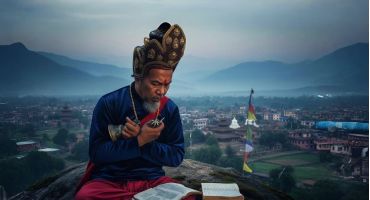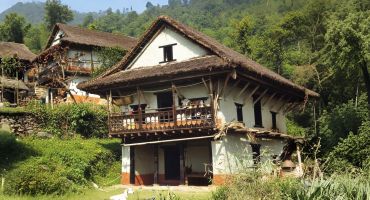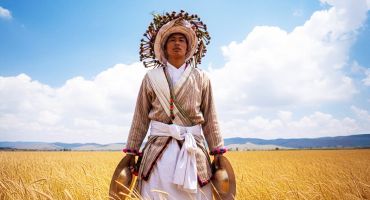Thōte (Tahote) is a ritualistic festival of the Tamu Gurung people, performed to forbid the entry of evil energies into the village community. Thōte, as an ancient tradition, is still an unchangeable rite in a Gurung society. Irrespective of geography and demographical vastness, the immediate natural domain of their habitat always forms a crucial part of the Gurung identity. The traditional history of Gurung rituals is vast, but special attention must be paid to Thōte, which, besides allowing us to focus on some of the aspects relating to the symbolic idea of community, also permits us to consider the relations that, through the idea of ritual, are instituted between the society and the supernatural entities that govern it.
In a nutshell, Thōte (Tahote) is a village worship festival, but the richness and complexity of its theme give it more meaning than just ‘forbidding evil forces from entering the village’. Thōte is a palpable display of the community’s lives and traditions connected intrinsically and spiritually to their traditional land, waters, and natural resources. The idea of ritual presented by Thote consists in an active form, many of the elements potentially present, or endured over time, amidst the Gurungs. Thōte serves various purposes- to banish evil from the village community, as a prayer for the protection of human life, cattle, and crops, and also as a glaring display of pride in cultural identity.
Thōte aims to address ritual ceremonies as the beginning of all power and energy to shape the village for the better, by warding off any unseen, unfavorable influence from the outside. We can be fairly certain that this tradition predates Tamu Gurung’s conversion to Buddhism. There is no particular tutelary village deity worshipped during the ritual. Instead, anonymous supreme spirits, without any human merit, but who hold vast sway over society, are either appeased or sent away from the village. Both the Pachyu, a traditional Shaman, and the Khyabri, the Buddhist Shaman, perform the ritual together. Even with different backgrounds, they perform their sacred functions, and primarily protect and reinvigorate the intangible forces that influence the village.

Almost all Himalayan tribes celebrate Udhauli and Ubhauli – rituals/festivals to appease the deities for the well-being of all sentient beings. Thōte can be considered the Gurung equivalent. As a rule, Thote is performed three days in Chaitra (March-April) and three days in Shrawan (July-August). They perform the rite on Tuesdays. Organizing the ritual and managing the entire array of ceremonies are always determined by the community elders upon reaching a consensus. While the Gurung community today is not strictly governed by a hierarchical system, it can be described as a society adapting to the present social structures through traditional respect awarded to the elders within the community. Planning and execution will require knowledge of the ritual, its significance, and an understanding of the interrelation of all these factors. Traditions and customary laws dictate that all the elders with abundant experience, gather at the village center, to determine and finalize the management plans of the ritual.
Before the beginning of the ceremony, the villagers perform the task of collecting numerous offerings needed: a specific amount of corn, millet, and rice. Each household has to provide volunteers and items necessary for the subsistence and survival of the ritual. In the village, each house is responsible for contributions, even though the household could subsidize individual members. Items like Ranijhar (Himalayan weed) and Bhakimlo (Rhus Chinensis/Nutgall Tree) are collected to cultivate ritual into a sacred process. The use of these items is significant to the Thote ceremonies and reinforces the transition of the normalcy of village life to ecstatic religious experiences. Different metallic weapons and musical instruments are also collected to be purified through the rite. These items, in the daily life of the individual or the group, acquire great importance, and it would seem, then, that without their presence in the village purification ritual, the ceremony is impossible. The ritual will be considered adequate and successful if the village can resolve all conflicts with the spiritual entities to revitalize energies through customary rites.
At least in general terms, the symbolic association of the community, from a social dimension, appears to be mutually integrated, as the entire village comes together for the preparation and management of the ritual and the festivities. Food is prepared collectively to appease the spirits. For sacrificial rites, Roosters are collected. A group of men and women gather to begin the village cleaning work as they clean out the drains, remove weeds and repair the pathways. The villagers gather branches of the Bhakimlo tree and hang them in the cardinal directions upon the entry/exit gates.

Some of the logs of the Bhakimlo are cut into fine pieces of wood. A thin wooden piece of this wood is called a fitlee. Temporary gates of Bhakimlo wood and Ranijhar weed are constructed, and five fitlees hang on them, creating an invisible division between the village and unknown space. The ritual, which at the macrocosmic level, runs between two sets of religious beliefs-Buddhist, and Bon– is represented on a reduced scale by the Bakhimlo branches that are marked with yellow paint to represent Buddhism’s colors in the Gurung ceremonial repertoire. Bhakimlo wood also hangs on the doors of the village houses.
Mock weapons, to be used as props during the ritual, are also made out of Bakhimlo wood. The Indigenous populace, in most cases, form self-sustaining plant communities that have successfully adapted to a local region, and they tend to resist damage from freezing, drought, and common diseases, with the help of indigenous plants in that particular region. Bhakimlo (Nutgall) has always played a similar role in the Gurung community’s survival for ages. Other materials, such as charcoal, turmeric, white and red soil or rice flour, bird feathers, and animal skins, if any in the village, for embellishing a performer, are collected. As the collection of all the ritualistic materials concludes, the elaborate ceremony and performances begin.
The ceremony begins with a procession from the entry gate. The villagers start a fire, and juniper incense burns over charcoal embers and butter. The shamans beat their drums, and the five Fitlees upon the gate, are worshipped and purified. A volunteer will carry the incense in a censer and lead the procession. The performers follow the volunteer with the mock weapons. It appears that the Gurung vision of their domain does not entail any firm split between two dimensions. Items of ritual are simultaneously relevant to the physical world and the spiritual realm. Every performer is required to commit to the performance. They enter the village roads, where their dances and pantomimes are staged to resemble a fierce battle, representing the averting of evil spirits and the restoration of balance at the end.

The performers disguise themselves as wizards, ghosts, and animals, and most wear tattered costumes made up of rags, animal skin, and feathers. They paint their faces, and the Ranijhar adorns their bodies. The organized sequence of events, rituals, and texts exist separately from the performers. The procession may be a ritual movement that requires contiguous control and physical cadence, but the performance is not scripted, nor does it adhere to conventional actions. Other participants walk behind them – whistling, shouting, and the beating of drums ensue. The procession will reach out to every house in the village, around which they will perform animated actions with loud noises and whistles to deflect evil energies. This procession reaches the exit gate where they will ignite a fire, incense, and worship the five fitlees believing that evil has left the village boundaries.
Outside the gate, the ritual resumes. A rooster is brought, purified by aspersing local alcohol, and sacrificed with a ritual hack. By performing the sacrifice, the Gurungs ask the spirits to return the ‘life force’ and catalyze the presence of ‘health’ within the village. Local beer and alcohol are offered to the spirits. After leading all those attending the rite outside the village, the sacrificial objects too shall remain outside. The rooster meat, and the remaining alcohol, are consumed by the participants. The village is proclaimed the place of protection and safety: the opposite of unknown space. The village gate changes polarity during the ritual and is transformed into a physical boundary between the invisible powers and humans. What affects the welfare of the village may subsequently, at the same time, apply to other realities- the unknown space, on a substantially greater scale; the hill where the village is located, on a smaller scale, and the human spirit, beyond everything else.





Preserving culture through writing is essential for safeguarding heritage and identity. When we document traditions, stories, and customs, we ensure that future generations can access and learn from them. Thank you for this article !
Thank you very much. Your comment is appreciated.